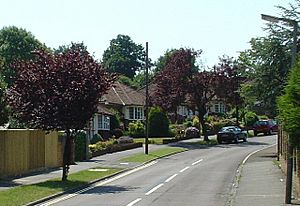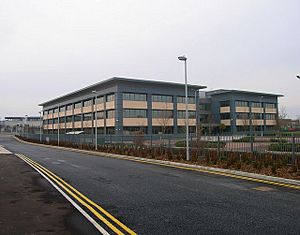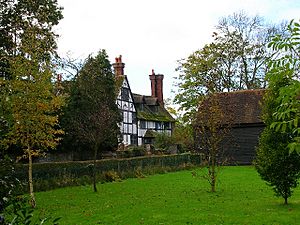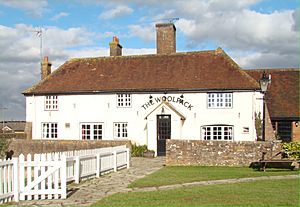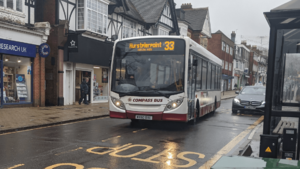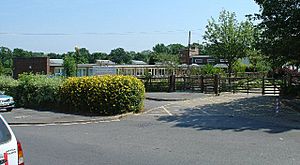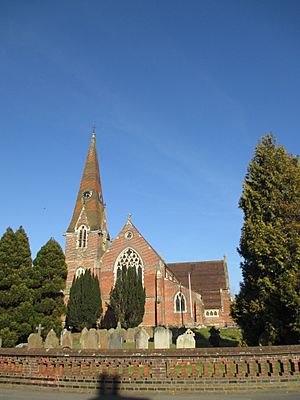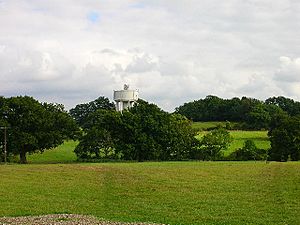Burgess Hill facts for kids
Quick facts for kids Burgess Hill |
|
|---|---|
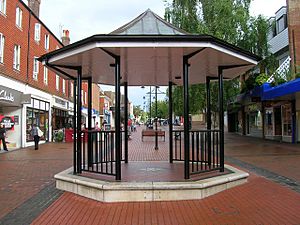 Looking up Church Walk, a pedestrianised shopping area |
|
| Area | 9.47 km2 (3.66 sq mi) |
| Population | 30,635 2011 census |
| • Density | 3,042/km2 (7,880/sq mi) |
| OS grid reference | TQ317187 |
| • London | 62 km (39 mi) N |
| Civil parish |
|
| District |
|
| Shire county | |
| Region | |
| Country | England |
| Sovereign state | United Kingdom |
| Post town | BURGESS HILL |
| Postcode district | RH15 |
| Dialling code | 01444 |
| Police | Sussex |
| Fire | West Sussex |
| Ambulance | South East Coast |
| EU Parliament | South East England |
| UK Parliament |
|
| Website | Town Council |
Burgess Hill is a town and civil parish in West Sussex, England. It is very close to the border with East Sussex. The town sits on the edge of the South Downs National Park. It is about 39 miles (62 km) south of London. It is also 10 miles (16 km) north of Brighton and Hove.
In 2011, Burgess Hill had a population of 30,635 people. This made it the fourth largest parish in West Sussex. It was the biggest town in the Mid Sussex District. Nearby towns include Haywards Heath and Lewes. A small part of Burgess Hill, called World's End, is actually in East Sussex. The Bedelands Farm Nature Reserve is on its northwest side.
Burgess Hill is twinned with two towns. These are Schmallenberg in Germany and Abbeville in France. This means they have a special friendship.
Contents
History
How Burgess Hill Began
A Roman road called the London to Brighton Way passed through this area. However, there is no proof that Romans ever settled here. Burgess Hill started from three older parishes: Clayton, Keymer, and Ditchling. These places are mentioned in the old Domesday Book.
The town's name comes from the Burgeys family. The name "Burgeys" meant someone who lived in a town. By the time of Queen Elizabeth I, a small community was already here. Many buildings from that time are still standing today.
People often wonder about the "hill" in the town's name. Some think it's the hill where the railway station is. Others believe it's Burgess Farm, which is on a hill in the southeast. No one knows for sure which hill the name refers to.
Long ago, the area was known as St John's Common. Much of what is now the town centre was common land. Local people used it for grazing animals and collecting fuel. There were only a few buildings, like the King's Head pub and a blacksmith's forge.
An annual fair was held on this common land every June 24th. This fair was for sheep and lambs. The last one took place in 1913. After the railway came, it was easier to transport animals by train. So, these local fairs stopped.
From 1700 to 1900
In the early 1700s, people started making bricks and tiles here. More houses and small businesses were built. Craftsmen like shoemakers and weavers also lived in the area. A company called Keymer Tiles made bricks and tiles until recently. Their tiles are on famous buildings like St. James Church, Piccadilly.
The London and Brighton Railway arrived in the 1840s. This was a huge event for Burgess Hill. The railway brought many new workers to the town. The Railway Tavern was built to house them. The railway also shaped how traffic moves in the town, which is still true today.
The railway made Burgess Hill a good place to live for people working in Brighton. Between 1850 and 1880, the area grew a lot. It went from a small village to a town with 4,500 people.
In 1857, the Hoadley family opened a large department store. The original building is still there today. It was a very successful business.
A big house called Wynnstay was built in 1876. It later became a nature cure centre called the Hydro. People came for the fresh air and views. Later, it became a convent and school for Catholic children.
In 1897, the Victoria Pleasure Gardens opened. They had a large lake for boating and skating. There was even a small early roller coaster! This area is now a business park.
From 1900 to Today
On July 12, 1944, a Royal Air Force Supermarine Spitfire plane crashed near the town. The Belgian pilot died.
Burgess Hill continued to grow. Its population almost doubled between 1951 and 1961. This made it the fastest-growing town in the South East of England. The Victoria Industrial Estate was finished by 1956. It has grown a lot since then. Another industrial estate, Sheddingdean, opened in 1986. Both are now called business parks.
In the 1970s and 1980s, many new housing estates were built. The biggest was West End Meadows. A new road was also built to connect to the A23. This helped with traffic.
The Bedelands Farm Nature Reserve became a special protected area. This stopped building in that spot. More houses were built in the 1990s, like the Hammonds Ridge estate.
The Triangle, a large leisure and conference centre, opened in 1999. The Queen herself opened it! In 2005, St Paul's Catholic College moved to a new site near The Triangle.
There have been plans to redevelop the town centre. These plans include new shops, a cinema, and a hotel. The old gasometer was removed and replaced with a supermarket.
The town is expected to grow even more. About 3,500 new houses are planned as part of the Northern Arc development. This will also include new schools and community facilities. A science park and industrial park are also planned.
Governance
Burgess Hill is part of the Mid Sussex area for the UK Parliament. This means people in Burgess Hill vote for a Member of Parliament (MP) to represent them.
The town used to be in East Sussex. But in 1974, it became part of West Sussex. A small part of the town is still in East Sussex.
Town Council
Burgess Hill has a Town Council. The town is divided into ten areas called "wards." Each ward has councillors who represent the people living there. In total, eighteen councillors represent Burgess Hill. The Town Council makes decisions about local services and issues.
District Council
From each of the six wards, two councillors are chosen to represent Burgess Hill on the District Council. The District Council makes decisions for the wider Mid Sussex area.
County Council
Burgess Hill is split into three areas for the County Council. These councillors represent the town at the county level. The County Council handles bigger services like education and roads.
Geography
Burgess Hill is located in the Sussex Weald. It is about 10 miles (16 km) north of Brighton. Haywards Heath is about 4.5 miles (7.2 km) south. Other nearby towns include Lewes, Horsham, and Crawley. Gatwick Airport is about 16 miles (26 km) north.
The town's shops and services are also used by people from nearby villages. These include Hassocks, Hurstpierpoint, and Ditchling.
A small river called Hambrook flows through the town. The town spreads out from its centre. Its growth is limited by a ring road on the west. On the east, it's limited by the county border and Ditchling Common. The northeast part of town, including Wivelsfield railway station, is known as World's End.
 |
Bolney, Horsham | Haywards Heath, Crawley, London | Crowborough, Royal Tunbridge Wells |  |
| Shermanbury | Chailey, Newick, Uckfield | |||
| Hurstpierpoint | Hassocks, Brighton | Lewes |
Nearest towns
- Wivelsfield
- Haywards Heath
- Hurstpierpoint
- Hassocks
- Brighton
Climate
Burgess Hill has an oceanic climate. This means it has mild winters and cool summers. It's similar to most of the United Kingdom.
Economy
Big Companies
Burgess Hill is home to many national and international companies. Many of them are located in one of the town's four business parks. These business parks employ about 8,000 people.
Some well-known companies with offices here include Filofax, Technetix, and Roche. Other companies like American Express and Porsche also have offices in Burgess Hill. Many people who work in Burgess Hill also live in the town. Others travel to work in nearby cities like Brighton, Crawley, or London.
Local Shops
The town has two main shopping centres: the Market Place and the Martlets. There are also many shops on streets like Church Road and Station Road. Several smaller shopping areas are found around the town.
Historic buildings
Hammonds Place is a beautiful old house from 1565. It was rebuilt by the Michelbourne family. Part of an even older building from around 1500 was kept. Grove Farm House and Farthings are also old, dating back to about 1600.
Other old buildings include Chapel Farm House and Walnut Tree Cottages. They are on medieval sites and date from the late Tudor period. Pollards Farm and Freckborough Manor House are also from this time.
High Chimneys and Fowles Farm are handsome farmhouses from the 17th century. West End Farm is now a pub called The Woolpack. The original farmhouse that gave the town its name is no longer standing.
Many Victorian houses and cottages built in the 1800s are still here. Back then, Burgess Hill was known as a healthy place to visit.
Transport
Roads: The main road connecting London to Brighton, the A23, runs west of Burgess Hill. The A2300 connects Burgess Hill to the A23. It was recently made into a dual carriageway. The A273 goes through the town centre, helping traffic move around. Other roads like the A272 road and several B roads also pass through or near Burgess Hill.
Bus services: Local buses are run by Compass Travel. They have services within Burgess Hill and to nearby towns and villages. For example, the 33 bus goes from Hurstpierpoint to Haywards Heath. Metrobus also runs services from Burgess Hill. Their buses go south to Brighton and north to places like East Grinstead and Crawley.
Railway: The London to Brighton railway opened in 1841. This helped Burgess Hill grow a lot. Burgess Hill railway station was built in 1877. Wivelsfield railway station opened in 1886 and serves the north end of town. Both stations have regular train services to London and Brighton. You can also travel to places like Worthing and Portsmouth from Burgess Hill. From Wivelsfield, you can go towards Hastings.
Education
Primary schools
- Birchwood Grove CP School
- Burgess Hill Girls (a private school)
- The Gattons Infant School
- London Meed Community Primary School
- Manor Field Primary School
- Woodlands Meed School
- Sheddingdean Primary School
- Southway Junior School
- St Wilfrid's Catholic Primary School
Secondary schools
- The Burgess Hill Academy
- Burgess Hill Pupil Referral Unit
- Burgess Hill Girls
- St Paul's Catholic College
Students from Burgess Hill also attend schools in nearby Hassocks, Cuckfield, and Haywards Heath.
Further education
- Burgess Hill Adult Education Centre
- Burgess Hill Girls (Sixth Form)
- St Paul's Catholic College (Sixth Form)
Religion
Burgess Hill has several churches:
- All Saints United Reformed Church
- Burgess Hill (Gateway) Baptist Church
- Methodist Church
- Centre Church Burgess Hill
- Sheddingdean Baptist Church
- St Andrew's Church (Anglican)
- St Edward's Church (Anglican)
- St John the Evangelist's Church (the main Anglican church)
- St Wilfrid's Church, Roman Catholic
- The King's Church
- The Point Fresh Expression Church (Anglican)
The International Bible Training Institute is also located in Burgess Hill.
Recreation and wild areas
To the northwest of Burgess Hill is Bedelands Farm Nature Reserve. To the east is Ditchling Common Country Park, a large area of common land. In the town centre, the biggest park is St. John's Park.
The Triangle leisure centre is on the northern edge of town. It has swimming pools and other sports facilities. It is also used for conferences. Queen Elizabeth II opened The Triangle in 1999.
Burgess Hill has its own independent cinema, the Orion Cinema. It opened in 1928 and has two screens. The town also has a local theatre that puts on plays and a popular pantomime.
The Mid Sussex Brass Band plays at local events and concerts. Burgess Hill also has a Symphony Orchestra and a Choral Society.
Sport
Burgess Hill Town Football Club plays football at Leylands Park. They are in the Isthmian South East Division.
Burgess Hill Rugby Football Club, also known as The Sussex All Blacks, plays rugby at Poveys Close. Burgess Hill also has a baseball team.
There are two main cricket clubs: St Andrew's CC and Burgess Hill CC. Both have adult and junior teams. Mid Sussex Hockey Club plays at The Triangle leisure centre. Mid Sussex Youth Netball Club also trains there.
The Triangle was once home to the Brighton Bears basketball team. Several local pubs have teams in the Mid Sussex Pool League. There is also a squash club and a running club in town.
The skate park in the town centre is popular and holds an annual competition. The Triangle was a training centre for teams during the London 2012 Olympic Games.
Local media
You can get TV signals in Burgess Hill from the Heathfield or Midhurst TV transmitters.
Local radio stations include BBC Radio Sussex, Heart South, More Radio Mid-Sussex, and Mid Sussex Radio.
The town's local newspapers are the Mid Sussex Times and The Sussex Newspaper.
Town twinning
Burgess Hill has special friendships with two other towns. These are called twin towns:
- Abbeville, Picardy – France
- Schmallenberg, North Rhine-Westphalia – Germany
A square in Schmallenberg has even been named Burgess Hill Platz!
Notable people
Many interesting people have connections to Burgess Hill:
- Caroline Atkins, a cricketer, was born here.
- Elizabeth Bartlett, a poet, lived here for much of her life.
- Neil Brand, a writer and composer, was born in Burgess Hill.
- Valentine Dyall, a voice actor, lived on Station Road.
- Martha Kearney, a journalist and broadcaster, went to school here.
- Greg Luer, a footballer, played for Burgess Hill Town F.C.
- Richard Midgley, a professional basketball player.
- Simon Nye, a TV writer, was born in Burgess Hill.
- Holly Willoughby, a television presenter, went to school here.
- Michael York, an actor, grew up in the town.
- Bobby Zamora, a professional footballer, lived here while playing for Brighton & Hove Albion.
Culture
The famous poet John Betjeman mentioned Burgess Hill in one of his poems called "Executive."
See also
 In Spanish: Burgess Hill para niños
In Spanish: Burgess Hill para niños



